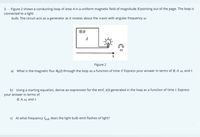Question

Transcribed Image Text:3. Figure 2 shows a conducting loop of area A in a uniform magnetic field of magnitude B pointing out of the page. The loop is
connected to a light
bulb. The circuit acts as a generator as it rotates about the x-axis with angular frequency w.
OB
A
Figure 2
a) What is the magnetic flux O3(t) through the loop as a function of time t? Express your answer in terms of B, A, w, and t.
b) Using a starting equation, derive an expression for the emf, t) generated in the loop as a function of time t. Express
your answer in terms of
B, A, w, and t.
c) At what frequency foulb does the light bulb emit flashes of light?
Expert Solution
This question has been solved!
Explore an expertly crafted, step-by-step solution for a thorough understanding of key concepts.
This is a popular solution
Trending nowThis is a popular solution!
Step by stepSolved in 3 steps with 4 images

Knowledge Booster
Similar questions
- a) What is the magnitude of the magnetic field at point P if I1 = 12.1 A and I2 = 33.7 A, in T? b) What is the direction of the magnetic field at point P with repsect to the figure?arrow_forwardh Previous Question WIT 60° B 1m 60° 1m 1m 1m 2m The wire has 5 segments each of 1 m can rotate around the axis shown in diagram. The wire is placed in a magnetic field of 1.0 T in magnitude and horizontal in direction as shown. Find out the magnitude of net magnetic force and torque acting on the wire w.r.t to given axis of rotation. BIU T TH axis FR 24°C Rain showersarrow_forwardThe uniform 30.0 mT magnetic field in the figure points in the positive z-direction. An electron enters the region of magnetic field with a speed of 5.50 x 106 m/s and at an angle of 30° above the xy-plane. (Figure 1) Figure X Z 000 30° 12 1 of 1 Part A Find the radius r of the electron's spiral trajectory. Express your answer with the appropriate units. I JA Value Submit Part B DO Request Answer Find the pitch p of the electron's spiral trajectory. Express your answer with the appropriate units. μÅ Value Units Submit Request Answer Return to Assignment Units www ? Provide Feedback ?arrow_forward
- A particle with charge q enters a region where there is a uniform magnetic field B= Bk. The initial velocity of the particle is ( = vi). The particle leaves the region with velocity (v = -vj), Find the distance between the points where the particle enters and leaves the region with a uniform magnetic field. a. qB Ob. 2qB 2mu C. qB d. V2mu qB e. qB 0 0 0 Oarrow_forwardTwo circular loops are placed as shown in the Figure. The smaller one has a radius of 3.1 cm and the other has a radius of 7.3 cm. What is the magnitude of the magnetic field at point P. Given that I = 19.2 A, I2 = 8.4 A, d = 5.5 cm and L = 193.3 cm. P L I, d. Xarrow_forwardA small circular coil of 20 loops of wire having a radius of 1 cm is at rest in the X-y plane (so the normal to the loop points in the +z-direction). A uniform magnetic field of 0.5 T is turned on in the +x-direction. What is the magnetic flux through the loop? a. 7.85 x 10 Tm² b. 1.57 x 10 4 T m² O c. 3.14 x 10 3 T m2 O d. 0 T m2arrow_forward
- Figure 1 shows a square coil of side 4.5 cm. A battery is connected to the coil and produces a current of 6.8 A. The coil is placed in a uniform magnetic field of flux density 5.67 mT as shown in Figure 1. A C Figure 1 i) Calculate the size and direction of the electromagnetic force that will act on side AB. ii) Calculate the size and direction of the electromagnetic force that will act on side BC. iii) Describe the motion of the frame immediately after the current in the frame is switched on. North Pole South Polearrow_forwardgive answer of a and b.arrow_forwardA. What is the current in the current loop? B. What is the current density J in the current loop? C. To decide whether this is a large or a small current density, find the ratio of the current density J in the current loop to the current density of a 8.0 A current in a 1.6- mm diameter wire. Express your answer using two significant figures.arrow_forward
- A magnetic field of 3.7 T passes through a single loop square coil of side length 6.6 x 102 m which makes 39.8° angle with the area vector of the coil. Find the magnetic flux associated with the coil in Wb/m2? a. 1.238258 b. 0.012383 c. 0.038881 d. 0.016117arrow_forwardc) with a current of I in the opposite direction (Figure 2). Assume that the currents are distributed uniformly over the cross sections of each conductor. i. Derive an expression for the magnitude and direction of the magnetic field at point a c. What is the advantage of using the coaxial cable as compared to a long straight wire? a b С Figure 2arrow_forward
arrow_back_ios
arrow_forward_ios